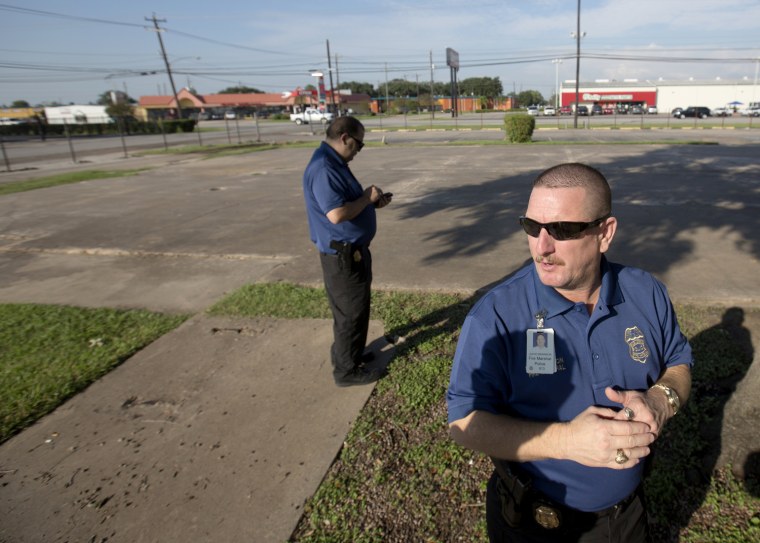PASADENA, Texas — Inside a fluorescent-lit training room in a squat office building in Pasadena, a city of 150,000 southeast of Houston, Robert Brown pointed his Nikon camera at two crime scene markers on a table in front of him. Brown, a local fire investigator, clicked, then leaned back and explained. “To get real blunt about it,” said Brown, 50, “When you take a picture of a burned body, to the untrained eye, you'd never see the body in there.”
Though there was no body in this field simulation, Brown was learning not only how to photograph one, but how to take a picture that could withstand the scrutiny of a criminal trial — how to use a tripod and flash correctly, how to approach depth of field, how to show the nuances of what might appear to be a “burnt pile” of junk, as he put it.
It was Brown's third hour of training that day, and his 740th hour of training this year. By the end of that mid-October week, he was on track to log nearly 800 hours.
This grueling schedule is part of a push by Pasadena Fire Marshal David Brannon to strengthen his arson investigators' training — and a dramatic departure from the annual 40 hours that are required by the state. It also offers a window into the effort to transform how arson standards are taught in a state where fire investigations have a well-known and acrimonious history.
Related: Old arson cases reviewed in Texas: Is Douglas Boyington an innocent man?
According to the Texas Forensic Science Commission, the cases against two Texas men — Cameron Todd Willingham and Ernest Ray Willis — were based on conclusions later determined to be unscientific. Both men were convicted and sentenced to death more than two decades ago. In 2004, Willingham was executed. Willis was exonerated.
A commission report released two years ago concluded with 17 recommendations meant to improve how arson investigations are conducted in Texas — reforms that ranged from conducting a review of old cases to following enhanced education guidelines (such as forensic photography) developed by the National Fire Protection Association.
“It was very clear that we had to refocus how fire investigators got their training,” said State Fire Marshal Chris Connealy.
A formal, science-based education is, after all, a relatively new concept for fire investigators. Before 1980, training was largely the domain of insurance investigators and fire fighters using unscientific methods. Training was frequently done on the job. Investigators learned from each other. Bad information spread easily. “There was no peer review,” said John DeHaan, who has written several editions of the textbook Kirk's Fire Investigations. Though science-based fire textbooks began to appear decades ago, the National Fire Protection Association's guidelines were not published until 1992.
But even after those guidelines were established, reform proceeded too slowly for some.
After the forensic science commission contacted then-Texas Fire Marshal Paul Maldanado in 2010 to inquire about the standards used in the Willingham and Willis cases, Maldanado wrote back, “In reviewing documents and standards in place then and now, we stand by the original investigator's report and conclusions.”
“This appears to be an untenable response in light of advances in fire science,” the commission replied.
For fire investigators, formal training was also difficult to come by. When Brown got his job in the Pasadena fire department eight years ago, he received an initial 140 or so hours of fire and arson training; since then he's met the required 40 hours per year. Tight budgets often left him searching message boards and websites for inexpensive, if not free, classes. “There were a lot of times where we may have found a class we wanted to go to and weren't able to because of funding,” Brown said.
To save money and meet the commission's recommendations, Brannon organized classes locally. He asked for and received additional funding from the city. And he moved as much money around as he could.

So far, Pasadena's seven investigators have logged an average of about 600 hours each this year.
The reforms are not mandated, and the state does not collect training data, so it is unclear how many of the state's 1,369 arson investigators are taking the same initiative.
In Lake Jackson, a small city near the Gulf Coast, Fire Marshal Randy Crim said that he was initially suspicious of the commission report. “The first time you read it, you thought, 'What's the purpose behind this?'” He ultimately came around, though, and said that new offerings, such as a class focused on natural gas and other explosions, have drawn him to roughly 20 additional hours of training this year, totaling about 150.
In Austin, Connealy has notified every fire investigator group in the state that he “embrace[d]” the commission report as a “blueprint toward the future.” Those who didn't do the same, he wrote in an October 2012 letter, “will not fare well in the future.”
He enlisted a group of scientists, engineers and other arson experts to conduct a review of old cases where bad science may have been used, and he began organizing forums and workshops. (The group has reviewed cases from Lake Jackson and Pasadena, among others; the Lake Jackson investigation was found to have been adequate, while Pasadena's was not.) He set up regional task forces so smaller agencies would get more on-the-ground experience. And he scaled up training hours for his office's 20 investigators from an average of 63 hours in 2012 to 125 this year.
So far, three have quit and one more was in the process of leaving.
“I can't tell you that there won't be a couple more,” Connealy said.
Related: